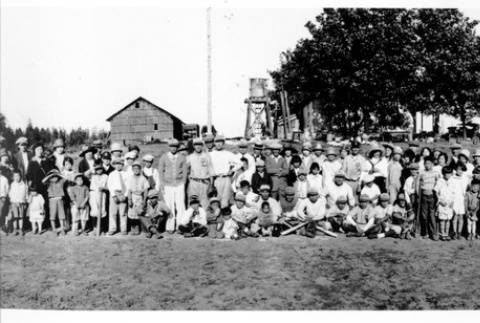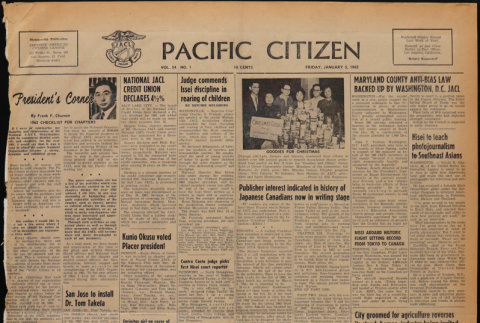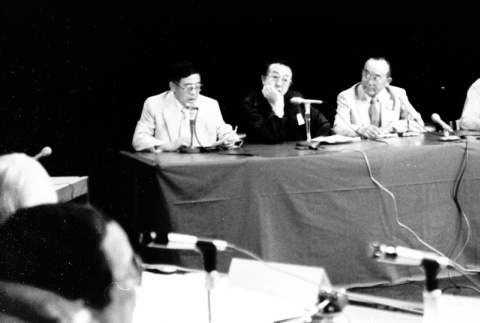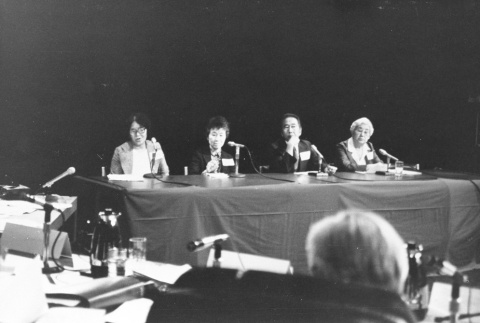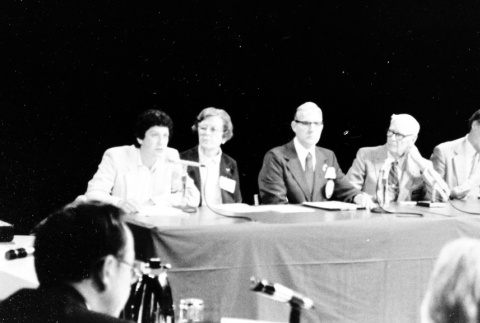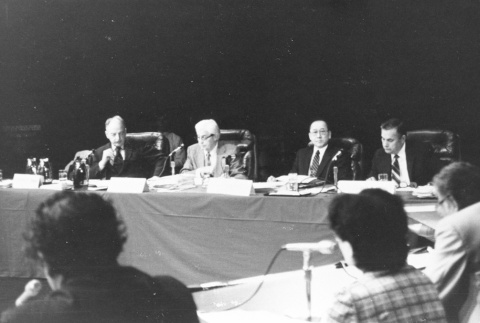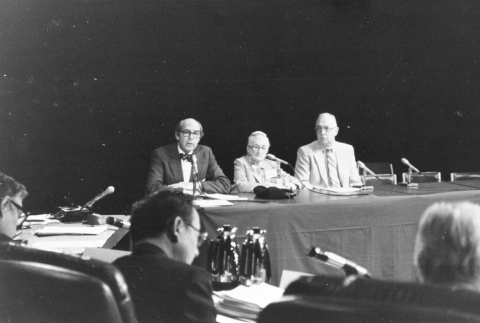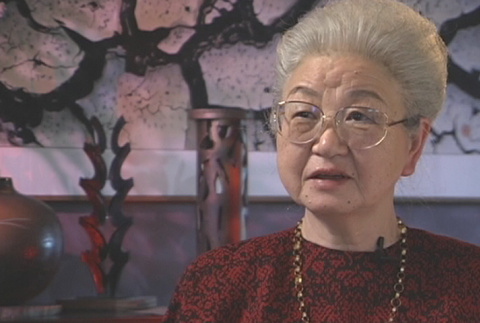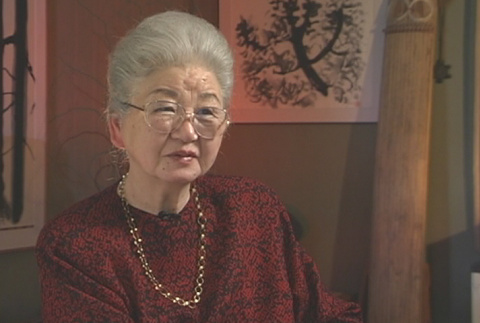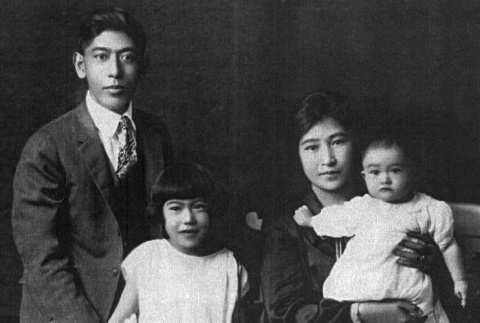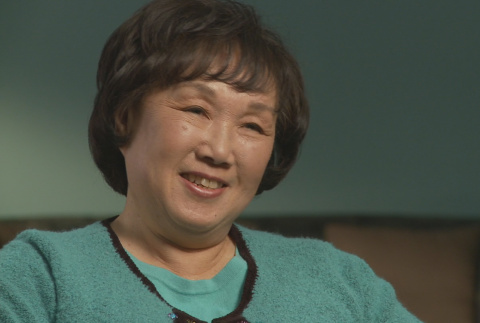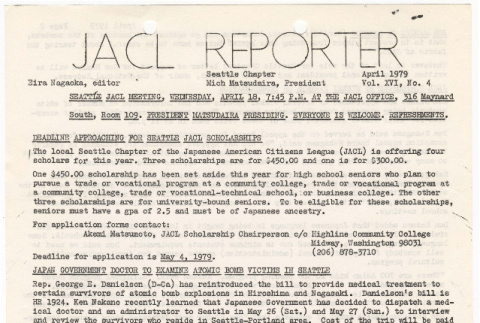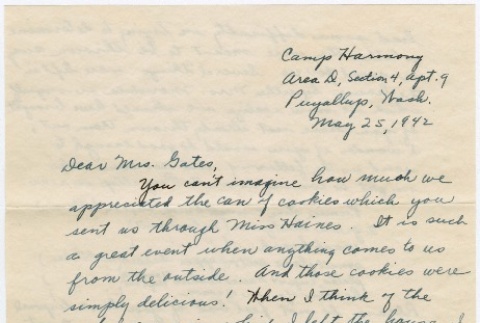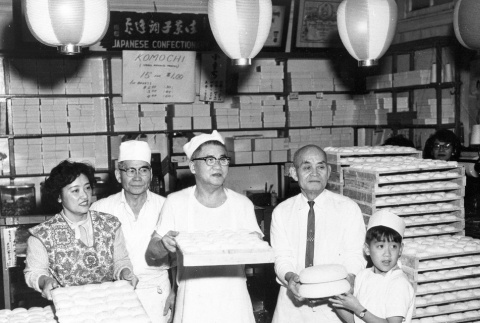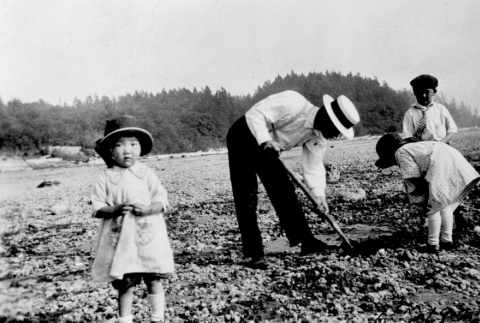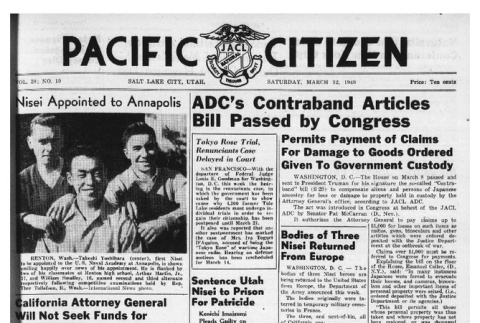10000 items
10000 items

Collection
Kanno Collection (ddr-densho-133)
The Kanno collection features three photographs of a Japanese American community gathering in the Green Lake neighborhood of Seattle, Washington. These photographs were also used in the book, The Green Lake Japanese American Community, 1900-1942.
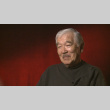
vh
Robert T. Ohashi Interview Segment 8 (ddr-densho-1000-350-8)
Meeting Japanese Americans from Seattle in the canneries
Nisei male. Born July 24, 1925, in Ketchikan, Alaska. Grew up in Ketchikan, where parents ran a store. During World War II, was removed to the Puyallup Assembly Center, Washington, and the Minidoka incarceration camp, Idaho. After leaving camp, went with family to work for a time in …
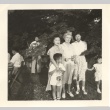
img
Visit from Ms. Mahon (ddr-one-2-156)
Black and white photographic print of Ms. Mahon (center) and unidentified individuals standing outside on lawn. Ms. Mahon served as the principal at Donor’s school, Bailey Gatzert grade school in Seattle, Washington. After Ms. Mahon retired, she visited Tokyo in 1950. Seattle’s Nikkei community raised the funds to pay for Ms. Mahon’s Japan trip. Inscribed on …
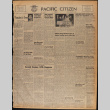
doc
Pacific Citizen, Vol. 54, No. 1 (January 5, 1962) (ddr-pc-34-1)
Selected article titles: "Maryland County Anti-Bias Law Backed Up by Washington, D.C. JACL" (p.1), "Publisher Interest Indicated in History of Japanese Canadians Now in Writing Stage" (p.1), "San Jose Nursery Plant Growers Win" (p.1), "Seattle Anticipates 10 Million Visitors During 184-Day Run of Century 21 World's Fair; Many JACLers Expected July 26-30" (p.4).
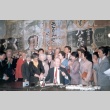
img
Governor signing redress bill for Seattle school clerks (ddr-densho-10-8)
Governor Booth Gardner of Washington State signs a state bill authorizing redress payments to twenty-seven former Nisei employees of the Seattle School District who lost their jobs during World War II due to their Japanese ancestry. (Information on back of the photograph.) The signing took place at the historic Nippon Kan Theatre in Seattle's International District, …

img
Redress hearings (ddr-densho-37-333)
The Commission on Wartime Relocation and Internment of Civilians (CWRIC) was created by an act of Congress on July 30, 1980. The committee was formed mainly to investigate matters surrounding the World War II internment of Japanese Americans and to recommend remedies. The CWRIC had no power to correct grievances. The hearings were conducted in twenty …
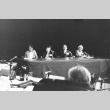
img
Redress hearings (ddr-densho-37-371)
The Commission on Wartime Relocation and Internment of Civilians (CWRIC) was created by an act of Congress on July 30, 1980. The committee was formed mainly to investigate matters surrounding the World War II incarceration of Japanese Americans and to recommend remedies. The CWRIC had no power to correct grievances. The hearings were conducted in twenty …

img
Redress hearings (ddr-densho-37-335)
The Commission on Wartime Relocation and Internment of Civilians (CWRIC) was created by an act of Congress on July 30, 1980. The committee was formed mainly to investigate matters surrounding the World War II internment of Japanese Americans and to recommend remedies. The CWRIC had no power to correct grievances. The hearings were conducted in twenty …

img
Redress hearings (ddr-densho-37-334)
The Commission on Wartime Relocation and Internment of Civilians (CWRIC) was created by an act of Congress on July 30, 1980. The committee was formed mainly to investigate matters surrounding the World War II internment of Japanese Americans and to recommend remedies. The CWRIC had no power to correct grievances. The hearings were conducted in twenty …
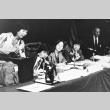
img
Redress hearings (ddr-densho-37-370)
The Commission on Wartime Relocation and Internment of Civilians (CWRIC) was created by an act of Congress on July 30, 1980. The committee was formed mainly to investigate matters surrounding the World War II incarceration of Japanese Americans and to recommend remedies. The CWRIC had no power to correct grievances. The hearings were conducted in twenty …

img
Redress hearings (ddr-densho-37-372)
The Commission on Wartime Relocation and Internment of Civilians (CWRIC) was created by an act of Congress on July 30, 1980. The committee was formed mainly to investigate matters surrounding the World War II incarceration of Japanese Americans and to recommend remedies. The CWRIC had no power to correct grievances. The hearings were conducted in twenty …

img
Redress hearings (ddr-densho-37-373)
The Commission on Wartime Relocation and Internment of Civilians (CWRIC) was created by an act of Congress on July 30, 1980. The committee was formed mainly to investigate matters surrounding the World War II incarceration of Japanese Americans and to recommend remedies. The CWRIC had no power to correct grievances. The hearings were conducted in twenty …

vh
Ayame Tsutakawa Interview II (ddr-densho-1000-95)
Kibei female. Born May 23, 1924, in the Hollywood area of Los Angeles, California. Sent to Japan to live with a relative when thirteen months old. Returned to United States and mother when twelve years old. Incarcerated at Sacramento Assembly Center and Tule Lake concentration camp, both in California. Resettled in Sacramento, California. Married George Tsutakawa, …
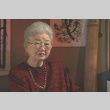
vh
Ayame Tsutakawa Interview I (ddr-densho-1000-94)
Kibei female. Born May 23, 1924, in the Hollywood area of Los Angeles, California. Sent to Japan to live with a relative when thirteen months old. Returned to United States and mother when twelve years old. Incarcerated at Sacramento Assembly Center and Tule Lake concentration camp, both in California. Resettled in Sacramento, California. Married George Tsutakawa, …

Collection
Akimoto Collection (ddr-densho-129)
The Akimoto collection contains three photographs of the Akimoto family, who operated University Cleaners, a dye works business located in Seattle, Washington. These photos were also used in the book, The Green Lake Japanese American Community, 1900-1942.

img
Issei at the Public Market (ddr-densho-36-46)
These Issei farmers are at the Public Market, in Seattle, Washington. By the World War I, Japanese Americans occupied seventy percent of the market's stalls. Here, they are donating vegetables to needy families. The Public Market is also known as the Farmer's Market and Pike Place Market. Original museum description: Japanese farmers had sold fruits and …
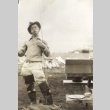
Collection
Frank Kubo Collection (ddr-densho-128)
The Frank Kubo Collection, 1910s-1960s, focuses on the leisure and business activities of a group of Japanese Americans from Seattle, Washington. Included are photographs of Seattle landmarks, Tsutakawa Company and Furuya Company picnics and camping trips, and Pacific Market, a Japanese American operated grocery store on Jackson Street in Seattle. Also featured are several photographs of …
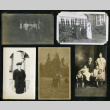
img
Japanese family (ddr-csujad-25-10)
A page from an album containing Japanese family photographs. Five photographs are pasted on the page. All photographs appear to be taken in Washington in the early 1900s. Include Japanese men in suits, women in western dress, and children. Include a family portrait which is taken at "Jackson Studio" in Seattle, Washington. Also include one photograph …

vh
Sally Sudo Interview (ddr-densho-1014-13)
Nisei female. Born December 1, 1935, in Seattle, Washington. During World War II, removed with family to the Puyallup Assembly Center, Washington, and the Minidoka concentration camp, Idaho. After leaving camp, resettled in Minneapolis, Minnesota. Spent many years raising a family and teaching in Japan before eventually returning to Minnesota.
(This material is based upon work …
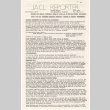
doc
Seattle Chapter, JACL Reporter, Vol. XVI, No. 4, April 1979 (ddr-sjacl-1-278)
Newsletter covering the following topics: Japanese Doctor to examine hibakusha victims in Seattle, Ken Nakano chair; Akemi Matsumoto announces 4 scholarship, 3-$450 and 1-$300; Ron Mamiya out as National Redress Committee Member?Interesting article on rift between National JACL and Seattle over carrying out the mandate from JACL National Council votes. Some big names like Bill Marutani …
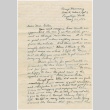
Collection
Gates Family Collection (ddr-densho-211)
The Gates Family Collection, 1942-1943, contains correspondence from the Matsuda and Morishita families to Mrs. Charles Gates. The Gates, Matsuda, and Morishita families were friends in Seattle, Washington before the outbreak of World War II and the correspondence covers the Matsuda's and Morishita's life at Puyallup "Camp Harmony" Assembly Center, Washington and later at Poston (Colorado …

Collection
Mamiya Collection (ddr-densho-13)
The Mamiya collection, c.1918-1960s, records the business and leisure activities of the Asaba and Shibata families of Seattle, Washington. Dance and graduation programs from the Minidoka concentration camp, Idaho, are also shown. Densho interviewed collection donor Yoshi Mamiya in 1998.
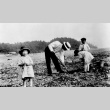
Collection
Wing Luke Asian Museum Collection (ddr-densho-39)
The photographs in the collection of the Wing Luke Asian Museum, Seattle, Washington, 1920s-1940s, focus primarily on oyster farming and the Minidoka concentration camp, Idaho. The images from Minidoka include barracks, schools, and leisure activities such as sports and arts and crafts.
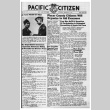
doc
The Pacific Citizen, Vol. 20 No. 5 (February 3, 1945) (ddr-pc-17-5)
Selected article titles: "Placer County Citizens Will Organize to Aid Evacuees" (p. 1), "Publication of Anti-Evacuee Acts Endorsed" (p. 2), "Seattle CIO Council Extends Welcome to Nisei Evacuees; Resolution Raps Race-Baiters" (p. 3), "U of Washington Paper Asks For Fair Play" (p. 3), "Deplore Attempts to Create Friction Between Nisei, Negroes" (P. 3), "171 Tule Segrees …

doc
The Pacific Citizen, Vol. 28 No. 10 (March 12, 1949) (ddr-pc-21-10)
Selected article titles: "ADC's Contraband Articles Bill Passed by Congress. Permits Payment of Claims for Damage to Goods Ordered Given to Government Custody" (p. 1), "California Attorney General Will Not Seek Funds for Enforcing Alien Land Law" (p. 1), "U.S. Films on Nisei Will Aid Return of Canadians" (p. 1), "University of Washington Group Studies Employment …
